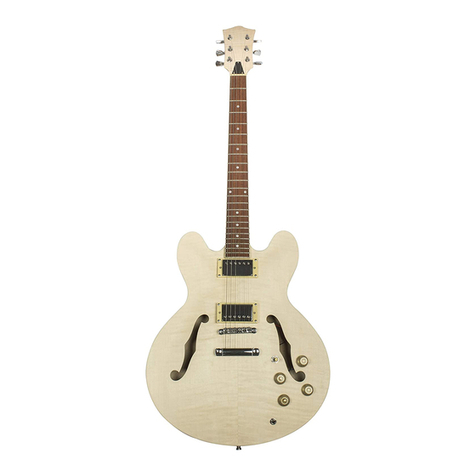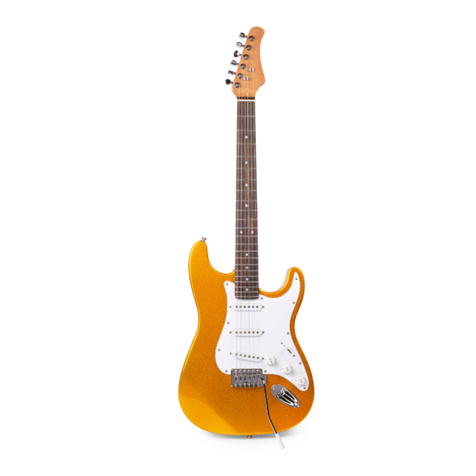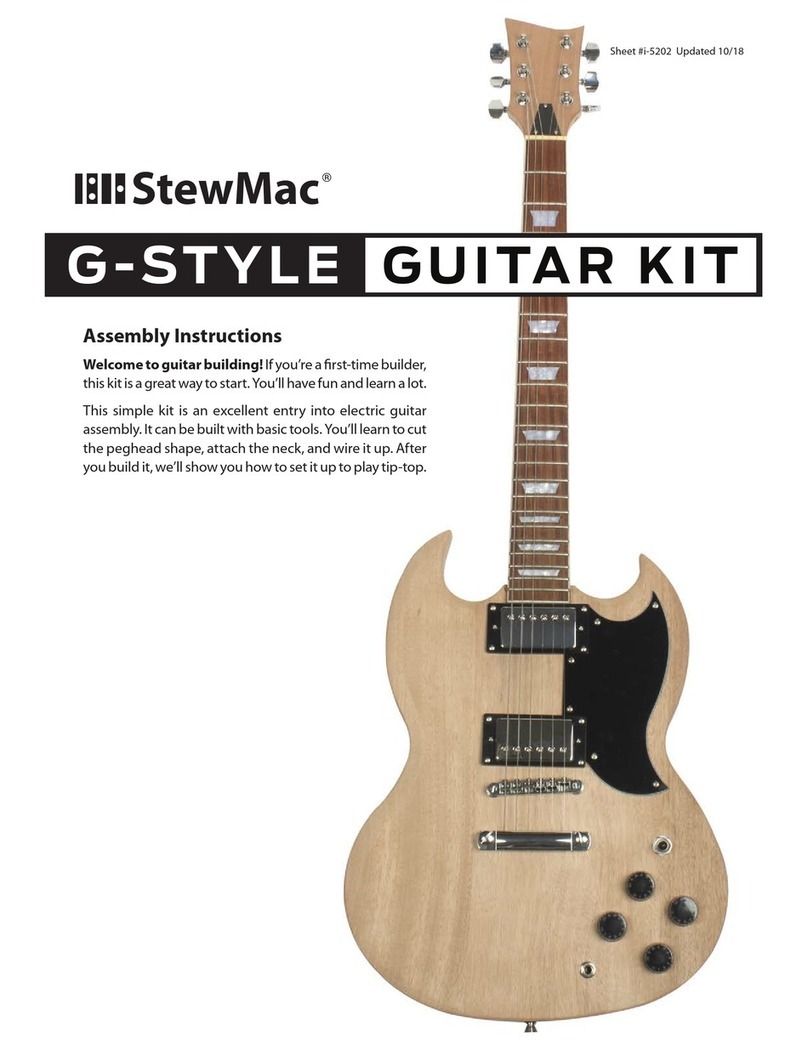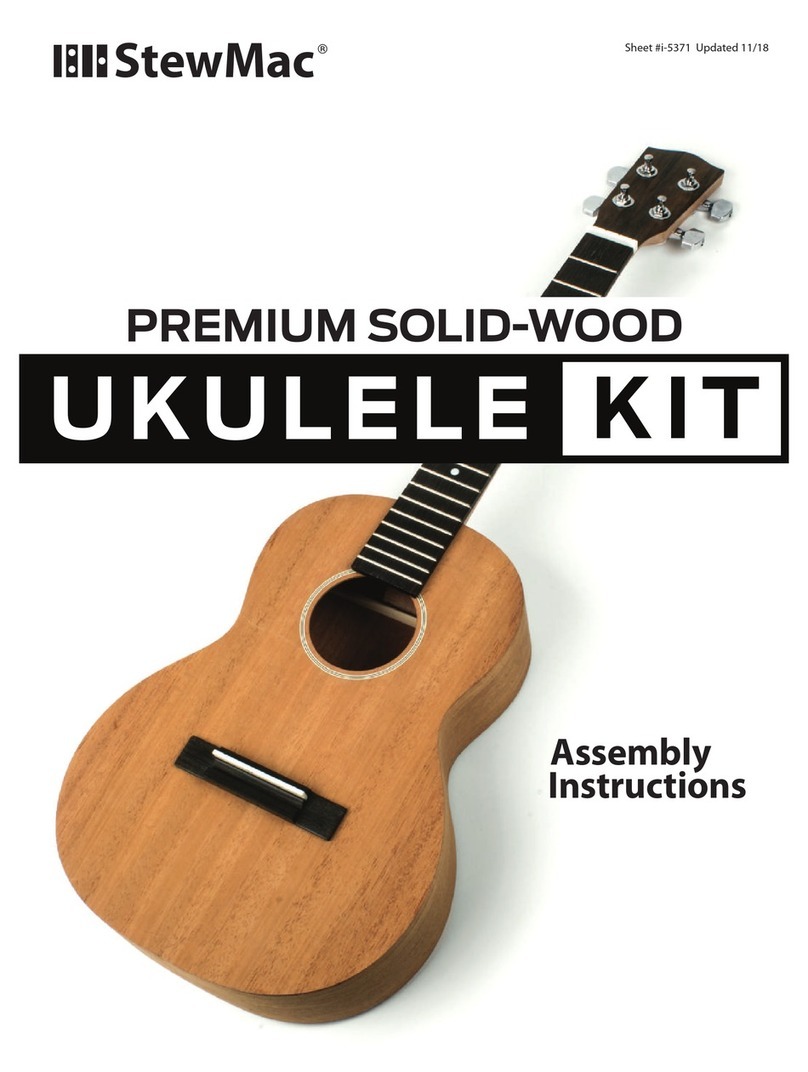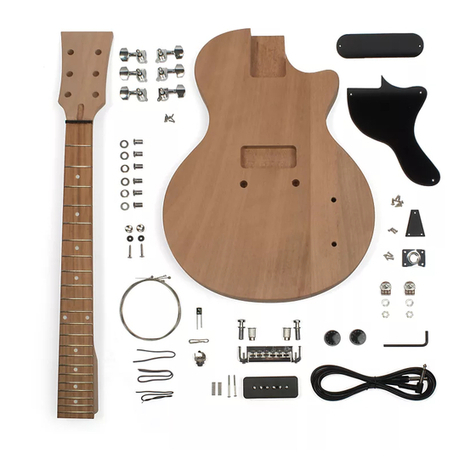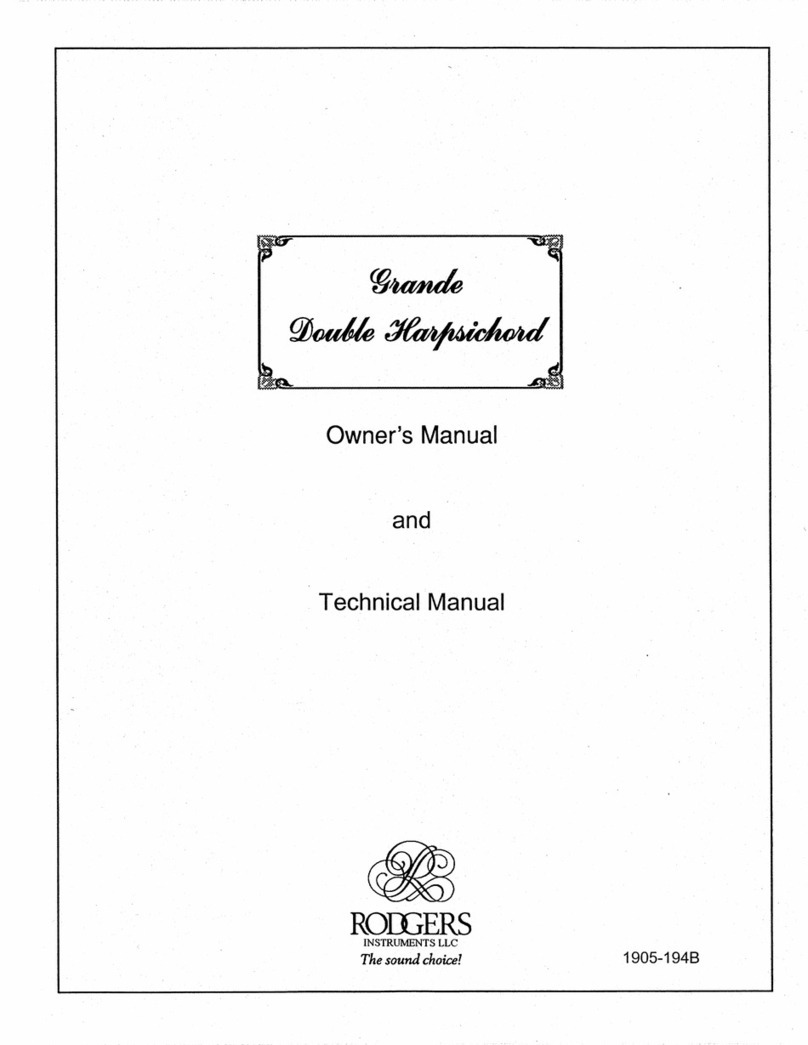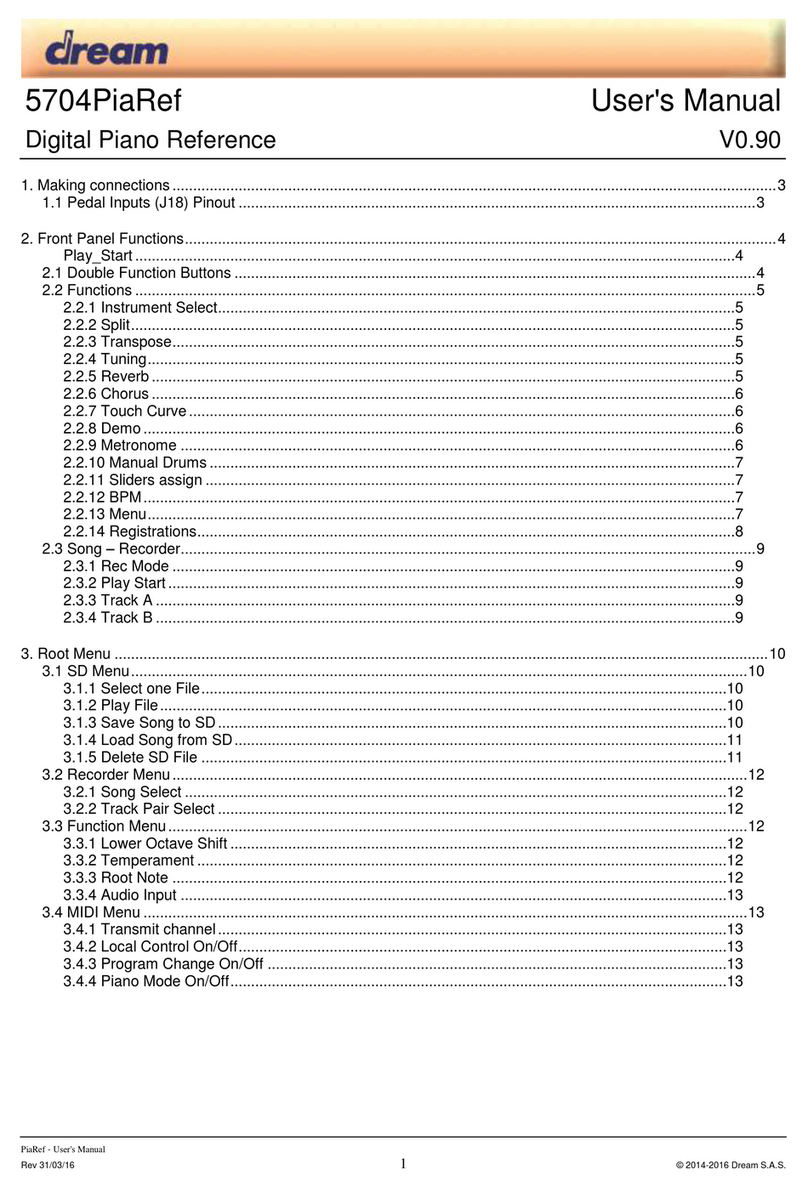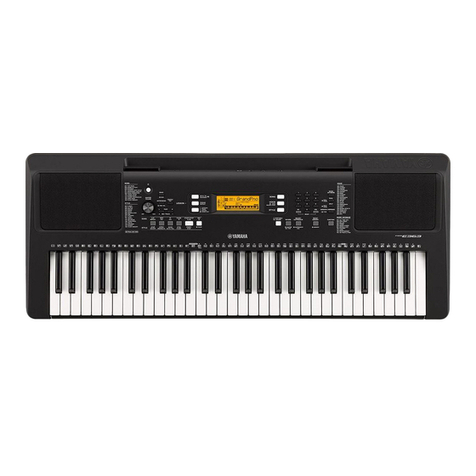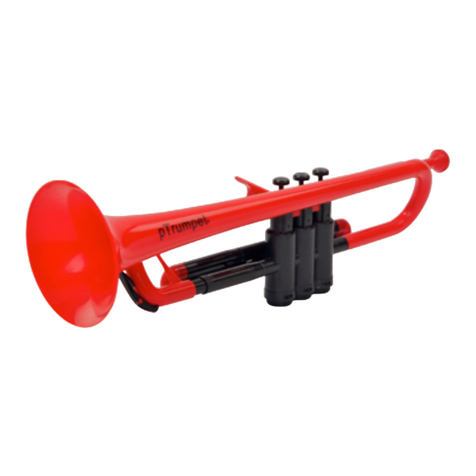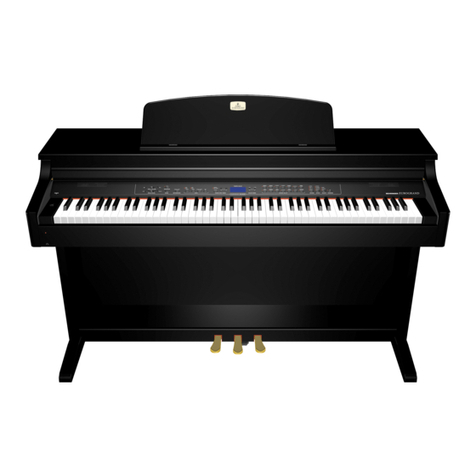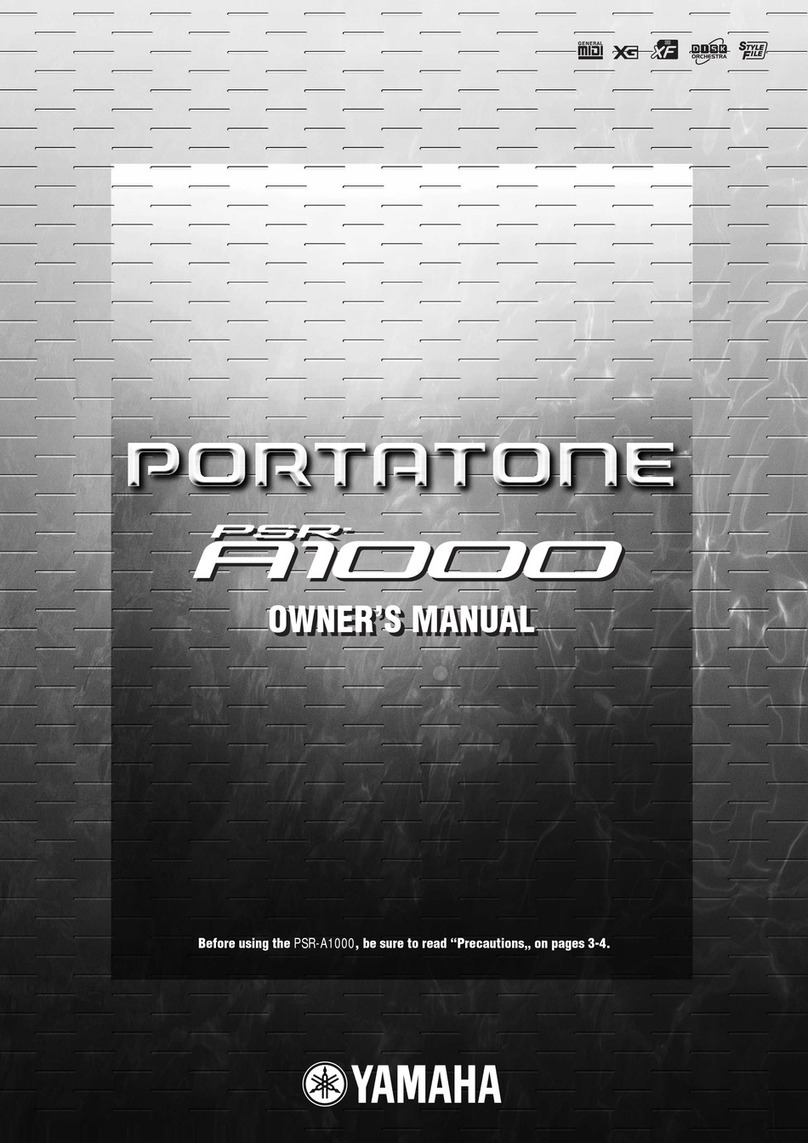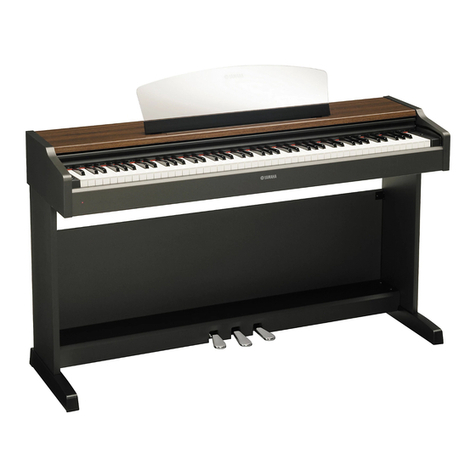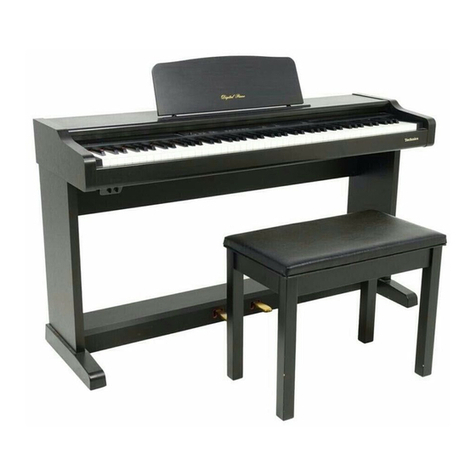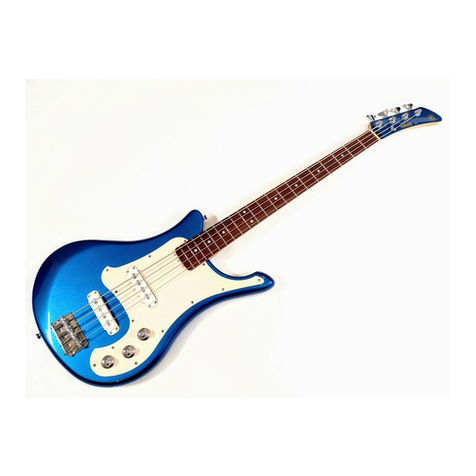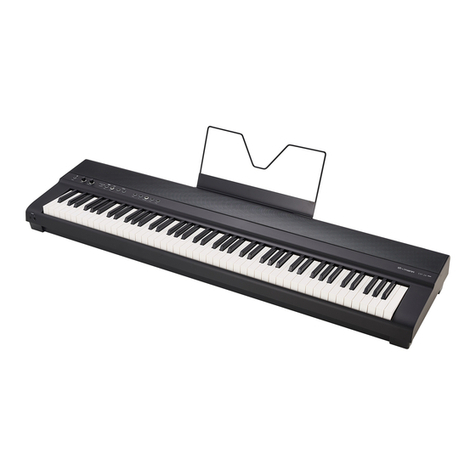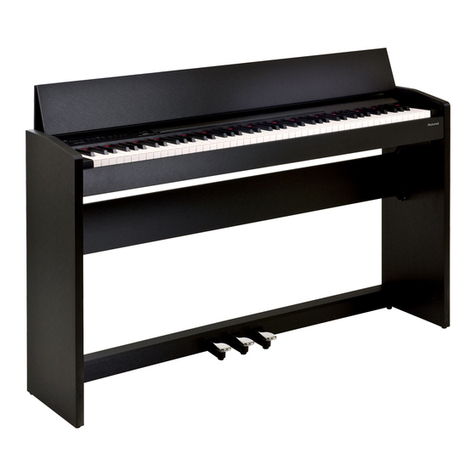StewMac MINI-T User manual

Have a little fun.
Make a little noise.
Build a REAL guitar in a weekend.
• Easy to build, nish, and setup
• Pre-wired electronics
• All hardware included
Sheet #i-12258 Updated 11/19
MINI-T GUITAR KIT

stewmac.com
2
These are the tools and supplies we recommend for assem-
bling this kit. Stewmac part numbers are included where
applicable.
Tools
Electric hand drill
Foam sanding block (#3701 or #3699)
Phillips screwdrivers, size #1 & 2 (#3000)
Center punch or awl (#3000)
Drill bits:
1/16" (#1710)
5/64" (#1712)
3/32" (#1714)
10mm nut driver (#5890) or wrench (#3691)
Solomon SL-30 Soldering Station (#0501)
6" StewMac Shop Rule (#4905)
12" Precision Straightedge (#3849)
Razor les, set of 2 (#4170)
Luthier's File Set (0842)
Jigsaw or coping saw
Supplies
Sandpaper: 150, 220, 320, 400 grits (#5562 or #5096)
Light duty 3M Scotch-Brite pad (#7445) or 0000 steel wool
ColorTone Naphtha (#0766)
Titebond Original Wood Glue (#0622)
Orange multi-purpose tape (#0678)
Masking tape (#0678)
Rubber Gloves
Rubber band
Finishing supplies
ColorTone Powdered Grain Filler, ebony (#0269-E)
ColorTone Wipe-On Poly Finish (#3622)
ColorTone Liquid Stain, Straw (#5109)
ColorTone Liquid Stain, Cherry Red (#5038)
Tools and supplies
16" RADIUS16" RADIUS
Cut-out radius gauge
Carefully cut out this radius gauge to check your saddle
heights as shown on page 10. We’ve included two, so you
have a backup.

stewmac.com 3
Parts list
Neck
Body
Slotted string nut
Neck plate with screws
Tuners with bushings, washers, and screws (set of 6)
Bridge with mounting screws and pickup installed
Pickguard with mounting screws and neck pickup
installed
Prewired control plate with mounting screws
Strap buttons with screws and protective washers (2)
String trees with screws (2)
Output jack with mounting screws
1.5mm hex wrench for adjusting bridge saddles
4mm hex wrench for adjusting truss rod
Strings

stewmac.com
4
Your guitar ships with the neck and bridge mounted to the
body, these will need to be removed for wood prep and
nishing work. Before getting started use a #2 screwdriver
to remove the neck and bridge from the body.
You can trace a favorite peghead or come up with a look
all your own. You’ll be cutting your design from the blank
peghead on the kit’s neck.
Make a paper template
Sketch out your peghead design on a piece of heavy paper
and cut it to shape with scissors. Using a pencil, trace the
shape onto the peghead. Use a light touch that doesn’t dent
or compress the wood which could make sanding out any
unwanted lines dicult. Don’t use ink, it leaves permanent
stains that bleeds through nishes.
Cut the peghead to shape
It’s important that your saw stays square to the face of the
peghead while you cut. If it tilts to an angle, you’ll get a
sloppy result that takes a lot of sanding to correct. Use a
bandsaw if you have one; a jigsaw is also good. A hand-held
coping saw can also be used, but it’s tough to hand-saw
smooth clean curves.
Never cut on the line
Always cut just outside the line, so you can sand to the line
afterward.
Smooth your saw cuts using rasps, les and sandpaper. Don’t
rush: rough patches will disappear into a good nal shape
if you take your time.
When you’re happy with your peghead shape, sand it
smooth using 150-grit sandpaper followed by 220-grit,
then 320-grit.
For info about using a template for peghead shaping, check
out our Trade Secrets video #335 “How To Shape A Custom
Peghead” at stewmac.com.
Create your peghead shape
stewmac.com search: ts335

stewmac.com 5
Preparing the neck and body for nish is just as important,
if not more important, than the nish application. The key
to a great looking nish is patience and lots of it.
Inspect the body and neck for any dents, chips, or other
imperfections and repair them. Small dents can be steamed
out by placing a damp cloth over the dent and applying
heat with a soldering iron. Chips, tear out, and knotholes
will need to be lled.
Sand the body and neck
Using 150-grit sandpaper on a at sanding block, sand the
entire body working only in the direction of the grain.
After a complete sanding, wipe the body with a damp cloth
to raise the grain, to reveal bers that need more sanding. Let
the dampness dry, then sand the raised grain with 220- grit
sandpaper. After sanding, raise the grain again and sand a
third time, using 320-grit sandpaper. Follow the same pro-
cedure while prepping the neck, using care not to sand on
the fretboard face or fret tops.
Run your ngers lightly along the edge of the fretboard and
feel for sharp fret ends. If the frets feel sharp where they
meet the edge of the neck, gently sand them back with long
strokes down the length of the neck. Use care not to change
the bevel of the frets in the process.
While sanding with 320-grit slightly break any sharp edges
on the fretboard body, ngerboard, and peghead. Soften-
ing these edges promotes an even nish build. It also helps
prevent sanding through the nish if ne sanding is needed
at the end of the job.
Degrease with naptha
When you’ve nished sanding, wipe the body and neck with
a naphtha-dampened lint-free rag to remove any oils or
grease. From this point on, wear clean gloves when handling
so you won’t contaminate the wood.
Tape o the string nut slot and fretboard face, they do not
get lled or nished.
Fill the grain
The body and neck of your guitar kit are made of mahogany,
which is an open grained wood. The grain will need to be
lled before nishing in order to achieve a at surface. We
suggest using our Ebony ColorTone Powdered Grain ller
following the instructions on the label. 2-3 applications
are recommended to get a nice at surface to build nish
coats over.
Prep for nishing
stewmac.com search: i-0269
TIP! Make holding handles for the neck and body. These can
be clamped in a vise or to a bench for lling and nishing, a
hanging hole can be added for drying. Nothing fancy, scrap
wood will do.
For more info on grain lling, see our article #i-0269 "Using
ColorTone Grain Filler" at stewmac.com.

stewmac.com
6
We stock a variety of nish types that can be used on your
guitar. For this kit we’ll be using our ColorTone Wipe On Poly.
It’s nonammable, simple to use, very forgiving, and can be
applied indoors.
Make an application pad out of cotton, an old t-shirt works
well. Make a wad about the size of a ping-pong ball to use as
the ller and tightly wrap it in the middle of a cover cloth. Tie
it up with a rubber band and you’re ready to go. You’ll use a
handful of these during the nishing process, 3-6 should do.
Color coats
ColorTone Liquid Stains mixed into the Wipe-On Poly make
an easy to apply and nice looking translucent nish.
For the body, mix 1/4oz of red (or the color of your choice)
ColorTone Liquid Stain into 4oz of the ColorTone Wipe-On
Poly nish and mix well. Conduct a test on some scrap wood
to ensure the color looks the way you’d like it to. If it’s too
dark, add a little more nish to weaken the color. If it’s too
light, add an additional drop or two of stain. Remember, a
small amount of stain goes a long way!
As you apply the color watch for streaks and uneven areas,
keep working the pad in a circular motion over these areas
followed by long strokes running the length of the instru-
ment until you have uniform tinting over the entire surface
of the body
For the neck, mix 1/8oz straw (or the color of your choice)
ColorTone Liquid Stain into 2oz of Wipe On Poly nish. Apply
the color to the neck in the same fashion as the body. Any
residual nish that ends up on the fretboard face will be
scraped back once it dries.
Allow the color coats to dry 2-3 hours.
Final top coats
Do not sand on your color coats. Apply 4-6 additional coats
of clear over the top of the color or until you’ve reached your
desired thickness. Allow 30 minutes to one hour between
coats and allow the nal coat to dry for 14 hours.
Applying nish

stewmac.com 7
Assemble your guitar
During assembly, use a padded surface to protect the nish
from scratches and dents.
TIP! Drag the threads of all mounting screws over a bar of
soap or wax to help them thread in easier.
Important! The pickguard needs to be positioned on the
body, but not mounted before attaching the neck.
Place the pickguard on the body running the neck pickup
lead wire through the wire routing holes and into the control
cavity. Do not mark out or screw down the pickguard at this
time. A rubber band will secure the guard in place while the
neck is attached.
Install neck
Install the neck mounting screws through the neck mounting
plate and tighten down with a #2 Phillips head screwdriver.
Install the pickguard
Using the neck and bridge for reference, position the pick-
guard. The idea is to have the front edge of the pickguard
running parallel to the bridge cutout on the pickguard. Once
positioned, mark out the mounting screw holes with a scribe
or punch. Drill 3/8" deep pilot holes for the screws using a
1/16" drill bit. Install the screws in the pilot holes.
Install the bridge
The mounting holes for the bridge are pre-drilled on the
body. The pickup comes installed into the bridge and is
ready to drop in. Run the pickup lead wire through the wire
routing hole into the control cavity, position the bridge and
tighten the mounting screws down with a #2 screwdriver.

stewmac.com
8
Install the nut
Apply a thin layer of wood glue to the bottom of the nut and
install it in the slot. Use care to make sure it is positioned
correctly side to side and is seated rmly to the bottom
of the slot on both the treble and bass sides. Wipe o any
squeeze out and run a piece of tape over the center to keep
it in position while the glue dries.
Install the tuners
Lay out the tuners, using a ruler to make sure they’re in line
with one another and square to the edge of the peghead.
Mark out your mounting holes with a scribe or center punch.
Tuner mounting screws are very delicate and will break o
if forced. Use a 5/64" bit to drill 3/8" deep pilot holes for the
screws; if these holes are any smaller you risk shearing o
the screw heads.
With the tuners in place, install the screws in the pilot holes
with a #1 Phillips screwdriver. On the tuner string post, add
a washer then the threaded bushing. Tighten with a 10mm
nut driver or wrench.
Drill for the jack plate
Mark out the 4 mounting screws with a scribe or punch
using care to keep the edge of the jack plate square to the
body. Drill the holes using a 1/16" drill bit. Do not install the
jack plate yet.
Install the strap buttons
Mark the locations of your strap buttons. At the tail of the
guitar, position the button in line with the center of the neck
and bridge. The other button is typically located on the tip
of the upper horn.
Drill 1/2" deep holes with a 3/32" bit and install the strap
buttons with their protective washers.
Assemble your guitar

stewmac.com 9
Assemble your guitar
Wire in the pickups
The switch and pots come pre-wired for an easy install, all
you need to do is wire the pickups to the switch using the
diagram below.
There is a coaxial wire and a separate ground wire attached
to the back of the volume pot. Clip the ground wire, it is not
needed. Run the hot and ground coaxial through the hole
for the jack.
Align the control plate
Align the control plate so it’s parallel to the treble edge of
the bridge. Mark out the hole locations and drill 3/8" deep
holes using a 1/16" bit.
Wire the jack
The bare ground wire gets soldered to the square (sleeve)
lug, solder the hot wire (usually yellow or white) to the round
(tip). Once soldered, install the jack plate on the guitar.
For more information on soldering check out our Trade
Secrets video #186 “How to get a good clean solder joint”
at stewmac.com
1 2 3 54 6 7
Lead from
bridge pickup
Lead from
neck pickup
stewmac.com search: ts186

stewmac.com
10
Set the action at the bridge
Adjust the action at the bridge by raising or lowering the
string saddles. Measure string height over the 12th fret,
between the bottom of the string and the top of the fret.
A good starting point is:
High (unwound) E string: 1/16" at the 12th fret Low (wound)
E string: 5/64" at the 12th fret
You can always go lower or higher depending on your play-
ing style. After setting the two E strings, dial in the remaining
strings to match the curve of the fretboard’s 16" radius using
the cut-out gauge on page 2.
Set the action at the nut
The string nut is pre-slotted for medium action, which is
comfortable for most players. If lower action is desired, you
can lower the slots using gauged nut les or needle les.
Straight neck, or a little relief?
Neck relief refers to adjusting a neck so that it has a very slight
upbow, rather than being perfectly straight. This relief allows
a little more room for string vibration, reducing the chance
of hitting the lower frets and causing fret buzz.
Depending on your playing style, and how perfectly level
your fret tops are, a neck should be anywhere from perfectly
straight to having 0.012" of relief. This measurement refers
to additional string height over the 12th fret, compared to
a perfectly straight neck.
A straight neck tends to play and sound better, but very few
guitars end up with no relief at all, and several thousandths
of an inch or more is perfectly normal.
Final setup
Turn the truss rod nut
counterclockwise to bring
the neck up, adding relief.
Measure string relief
at the 12th fret.
Turn clockwise to pull the
neck back, reducing relief.
Go slow: a little does a lot!
Install the string trees
Install the strings and mark the locations for the string re-
tainers on the peghead. These retainers maintain the proper
string angle over the nut for the D, G, B, and E strings. Use a
5/64" bit to drill 3/8" deep pilot holes.
Using a #1 screwdriver install the D/G string retainer between
the E and A string posts (approximately 2-7/8" from the nut).
Install the B/E string retainer under the D string post (ap-
proximately 3-3/8" from the nut).

stewmac.com 11
Set the intonation
The last step is intonating the guitar by adjusting the string
lengths at the bridge saddles so the guitar plays in tune all
the way up the neck.
Using a strobe or other accurate tuner, rst tune the strings
to pitch. Then, press the high E string lightly at the 12th fret
using just enough pressure to sound the note. Check it with
your tuner.
If the note reads at, the saddle needs to be adjusted forward
towards the nut, shortening the length of the string.
If the note reads sharp, the saddle needs to be adjusted back
away from the nut, increasing the string length.
You’re done!
Congratulations! Your guitar is ready to play. We hope this
will be the rst of many that you have fun assembling and
customizing.
Adjust the pickup height
Holding down the low E and high E strings at the 22nd fret,
adjust the bass side of the pickups to 5/64" from the top of
the pickup pole to the bottom of the low E string. Adjust the
treble side to 1/16".
Final setup

21 N. Shafer St • Athens, Ohio 45701 • USA
USA & Canada call toll-free: 800-848-2273
9am-5pm weekdays Eastern time
stewmac.com
Table of contents
Other StewMac Musical Instrument manuals
